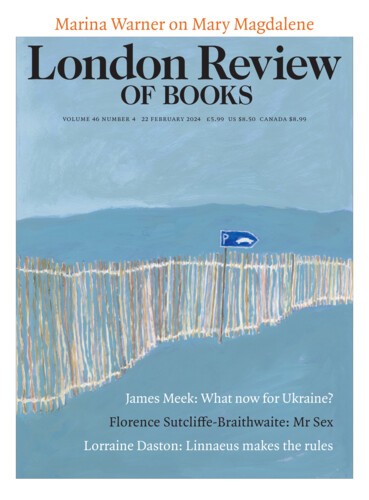The Imperial War Museum was established in 1917, while the fighting was still going on, ‘as a record of the toil and sacrifice of those who had served in uniform’ during the Great War. It was first called the National War Museum; the change to ‘Imperial’ was made after India and the Dominions complained that the name did not reflect their sacrifices. Today it describes itself as a ‘global authority on conflict’. It is a subdued and serious place, eager to point out that it does not celebrate war or victory; it was never supposed to be a frozen military parade, even if the suspended Spitfire in the main atrium – the military equivalent of the Natural History Museum’s Diplodocus – appeals directly to Britain’s neurotic Second World War triumphalism. Toil and sacrifice remain the watchwords. (Only in the gift shop does discipline break down, with poppy-spattered kitchenware and Churchill cult icons playing to a less reconstructed wartime imaginary.)
The museum’s commemorative ethos presents war as a kind of social paroxysm, which from time to time afflicts ordinary men and women. A carefully weighted combination of historical exactitude and apolitical detachment can be maintained for the world wars, as they were joined in defence against aggression and fought by conscript armies; with 9/11 and ‘terrorism’ emerging as the pivot point, the museum also shows ambiguous signs of trying to construe 21st-century engagements in Iraq and Afghanistan as similar tragedies of necessity. There is some justice in this approach. Soldiers do not start or choose the conflicts they are shipped off to fight. But many of Britain’s 20th-century conflicts would not respond well to the same treatment: the Kenyan torture camps, the Special Night Squads of Palestine, the beheaders of the Malayan Emergency and Britain’s other dirty wars of colonial counterinsurgency are not easily transformed into neutral objects of genuflection. Castrating prisoners with pliers is the wrong kind of toil and sacrifice.
This means that there is a great deal of modern British military history that the IWM simply cannot present to the public, except in adumbrated form. War might be hell, but with the exception of the Nazis, the people condemned to it are not to be held responsible for its horrors. Instead, the experience of war is reframed as a form of sufferance and it is the idea of the witness, rather than that of the soldier, that emerges with the most clarity. Soldiers are considered as a species of witness, as are army medics and engineers. Civilians, victims of war and terror, and people on the home front are also witnesses; even objects and machines are witnesses – ‘all these objects are witnesses to the Second World War,’ explains the first information panel on the ground floor, standing next to the decayed fuselage of a Japanese fighter jet. The final object in the ‘Peace and Security’ display is an actual witness box, extracted whole from the courtroom in which Abdelbaset al-Megrahi and Lamin Khalifah Fhimah were tried for the bombing of Pan Am Flight 103 over Lockerbie. Standing among dead machines, silenced weapons and old clothes, the museum visitor takes on the same role, and is made witness to what human beings have done and continue to do to one another.
The turn towards witnessing puts image makers in a central position, and artists, photojournalists, camera operators and photographers are prominent throughout the museum. The IWM has an extensive collection of military film and photography. At its core are a handful of reels that constitute one of the 20th century’s most important documents of witness: the films taken by Sgt Bill Lawrie and Sgt Mike Lewis of the Army Film and Photographic Unit (AFPU) in the ten days after the liberation of Belsen. The AFPU had been set up in 1941 to gather moving images and stills of the war, in part because it was feared that the Nazis were producing more and better propaganda material than the British. After training, cameramen were given officer status, allowing them to go right up to the front line and film without oversight. The reels were sent back to Britain, along with detailed ‘dope sheets’ describing what they had captured, and then edited into newsreels and propaganda films. The IWM holds the AFPU’s entire archive.
When I used to work with old films in the IWM, trekking round to the adjunct buildings on Austral Street to sit at grey and silver Steenbecks in the film department, the AFPU reels of Belsen were by far the most frequently requested items among public visitors to the archives. As I made notes to lo-fi homemade flicks of British squaddies roughing up suspects in 1960s Aden or dynamiting Palestinian homes during the Mandate, people in the other cubicles were witnessing the abyssal horror that Lawrie and Lewis had captured over and over again. I often heard visitors crying. The IWM’s new Holocaust galleries terminate in a devastating room documenting the liberation of the camps, central to which are films and images taken by the AFPU. The footage is quietly understood as the dark jewel in the museum’s crown, a scrying glass into a hell of human making.
Sgt Lawrie’s first dope sheet from Belsen, written up on 17 April 1945, is on show in the museum’s Blavatnik Galleries, which opened last November. ‘Scenes such as were witnessed by the first troops to arrive,’ he writes, ‘are beyond all human comprehension.’ The new displays are arranged around a central hub which is dedicated to those who have documented conflict. Lawrie’s dope sheet is shown here alongside press cards and video cameras used by journalists during the second Iraq War, an AFPU-issue DeVry camera and still cameras of various types and vintages, POW sketches by Ronald Searle, John Nash’s paintbrushes, Edward Ardizzone’s war diaries and many other similar objects. They are the tools of the trade, presented as relics or sacred accoutrements; surrounding them on the walls are dozens of photographs of wartime journalists, photographers and filmmakers at work. The wall texts don’t use the term ‘artist’, preferring the clumsy but more capacious phrase ‘visual practitioner’, in order to avoid privileging art over journalism.
Although the museum has only in recent years focused on journalism as a crucial kind of wartime witnessing, the displays already seem nostalgic. The IWM’s commitment to the memorialisation of the World Wars and the Holocaust binds it to understandings of international justice and wartime lawfulness that emerged in the wake of the Nuremberg trials. Those laws and ideals have of late been abandoned by the very nations that devised them. A new kind of anachronism has overtaken the IWM: it now stands for values that its own government has reneged on.
The day before my visit in early January, the journalist Hamza al-Dahdouh, son of Al Jazeera’s Gaza bureau chief, Wael al-Dahdouh, was killed by the IDF in Gaza. Wael’s family had already been targeted, near the start of the Israeli assault: in October he lost his wife, a son, a daughter and a grandchild when their shelter was bombed. Gaza has been the deadliest conflict for the press on record. Earlier this month, the UN reported that more than 122 journalists and media workers had been killed, a death toll unprecedented in modern wars. Yet the systematic murder of their Palestinian colleagues has barely been registered in the Western press. The IWM may have arrived at the conclusion that the journalist is a crucial figure for understanding conflict, but only some journalists are afforded that status in the field. Others are regarded as targets.
In the main hall of the museum, beneath the Spitfire and a Harrier jet that saw action in Afghanistan, is a battered Reuters press van, struck in Gaza in 2006 by a rocket fired from an Israeli helicopter. Two journalists, Fadel Shana and Sabbah Hmaida, were travelling in it at the time; both were badly injured but survived. The video information panel describing the attack has footage of the aftermath of the strike as well as clips of an IDF spokesperson, who says that the vehicle would not have been targeted had it been clearly marked. But there stands the evidence: a white van with the words ‘PRESS’ and ‘TV’ emblazoned on the surface in large red letters. Having survived the attack that put the van out of commission, Shana was killed by an Israeli tank shell in Gaza in 2008. The final video sequence is the record he made of his own death. Filming from inside a press car, Shana’s camera focuses on a tank stationed between trees in the distance, its turret aiming straight back. There is no movement, no incident. Then the muzzle flashes, and the screen goes black. The tank commander said he thought Shana’s camera was a rocket launcher.
Send Letters To:
The Editor
London Review of Books,
28 Little Russell Street
London, WC1A 2HN
letters@lrb.co.uk
Please include name, address, and a telephone number.


